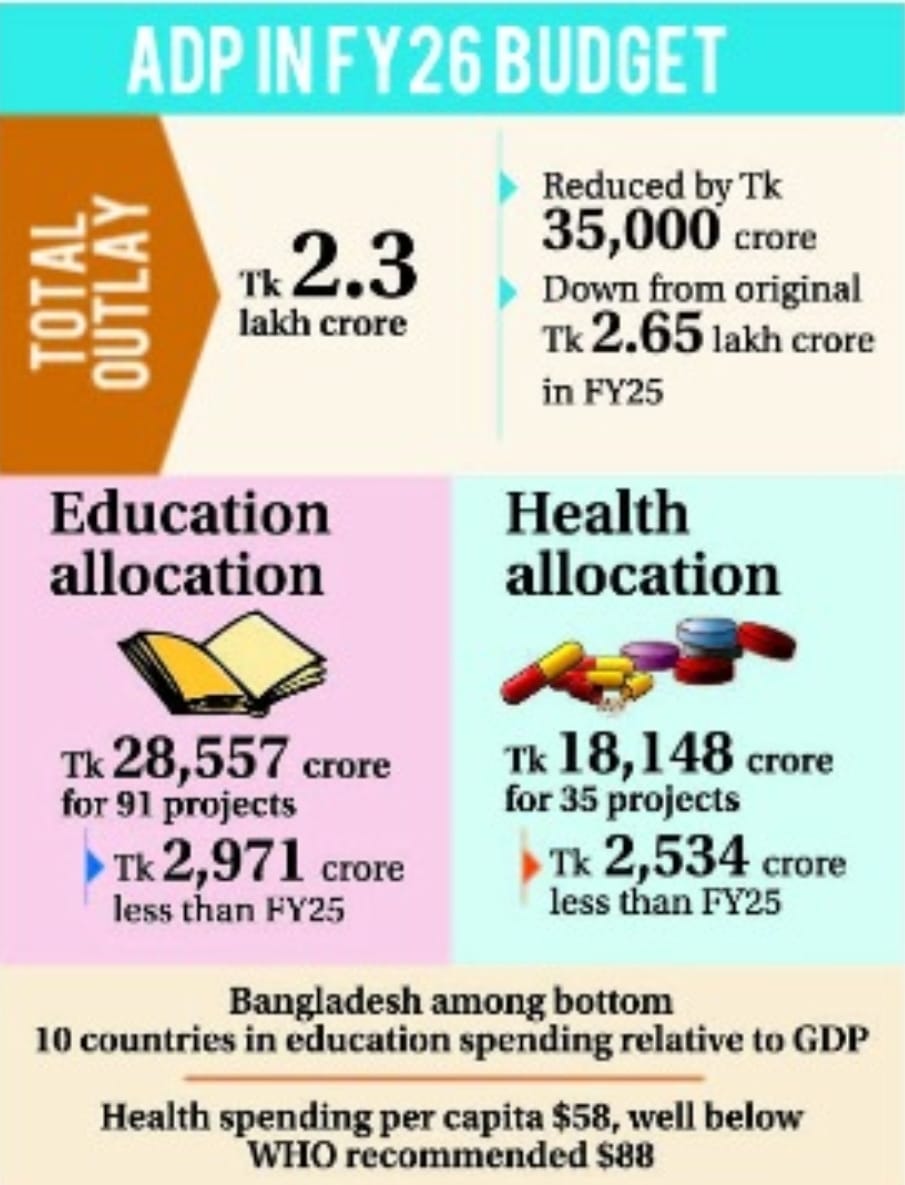Despite expectations for reform and increased investment, the interim government is proposing reduced allocations for education and health in the upcoming Annual Development Programme (ADP) for the fiscal year 2025–26.
According to a draft finalised by the Planning Ministry on 6 May, both sectors—crucial to long-term human development—are set to see significant cuts in development funding. In the current fiscal year, education and health were already seen as underfunded, and this trend appears to be continuing.
According to planning ministry sources, the proposed draft of the new ADP will be presented for approval at the National Economic Council (NEC) meeting, which will be chaired by Chief Adviser Muhammad Yunus.
The allocation for the education sector is expected to be reduced by approximately Tk 2,971 crore, bringing the total down to Tk 28,557 crore for 91 projects. In the current fiscal year, the original ADP had earmarked Tk 31,528 crore for education.
The health sector is also facing a cut of around Tk 2,534 crore. For 35 projects, the upcoming ADP proposes an allocation of Tk 18,148 crore, down from Tk 20,682 crore in the ongoing fiscal year.
Such reductions have raised eyebrows among economists and development experts.
According to Professor Selim Raihan, executive director of the South Asian Network on Economic Modeling (SANEM), people had expected the interim government to introduce reforms in education and health financing.
He added that this could have been an opportunity to shift away from outdated budget structures and move towards a more reform-oriented allocation framework.
Professor Raihan, who teaches economics at the University of Dhaka, noted that lower revenue collection and reduced foreign borrowing may have influenced the decision to cut back on development allocations in these sectors.
Moreover, he pointed out that implementation capacity remains a persistent issue—many ministries fail to spend their full allocations effectively.
Officials at the Planning Ministry echoed these concerns. They said the reduced allocations reflect a strategy to distribute resources more realistically, focusing on sectors with proven spending capacity.
Bangladesh already ranks among the bottom ten countries globally in terms of education spending relative to GDP, according to World Bank data.
Similarly, the World Health Organization estimates that basic healthcare services require an annual per capita expenditure of $88. In contrast, Bangladesh spends only about $58 per capita on healthcare, the bulk of which comes directly from citizens’ pockets.
The total size of the upcoming ADP has been significantly reduced by Tk 35,000 crore, bringing the new ADP size to Tk 2.3 lakh crore—down from the Tk 2.65 lakh crore originally approved for the current fiscal year.
Of this, Tk 1.44 lakh crore will come from domestic resources, while Tk 86,000 crore will be sourced through foreign aid and project assistance. The new ADP includes a total of 1,142 development projects.
Despite cuts in education and health, transport and communication have been given the highest priority, with an allocation of Tk 58,973 crore. The power and energy sector follows with Tk 32,392 crore.
Education ranks third with Tk 28,557 crore, followed by housing at Tk 22,776 crore, health at Tk 18,148 crore, and local government and rural development at Tk 16,472 crore.
Other sectors include agriculture (Tk 10,795 crore), environment, climate change and water resources (Tk 10,641 crore), industry and economic services (Tk 5,038 crore), and science and technology (Tk 3,894 crore).
Almost all major sectors are seeing reduced allocations compared to the current ADP, indicating a broad tightening of development spending across the board.


